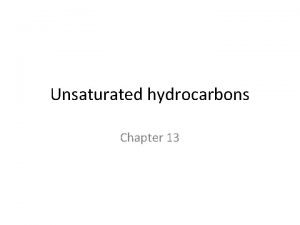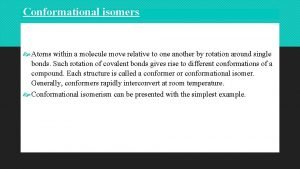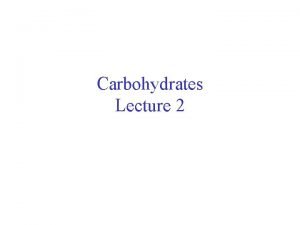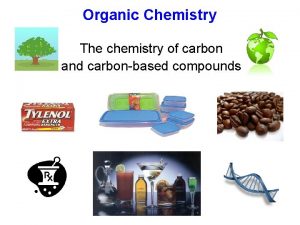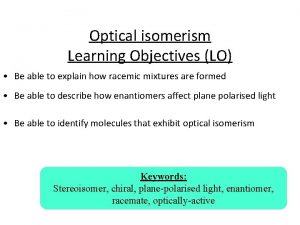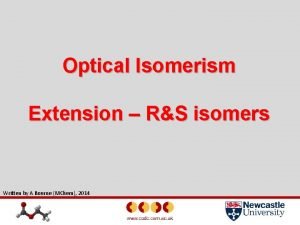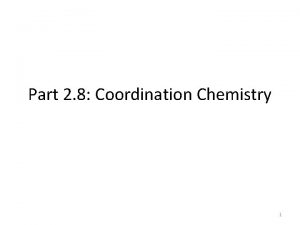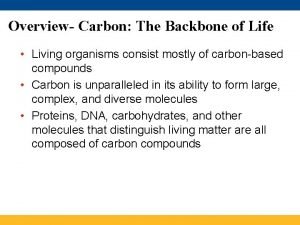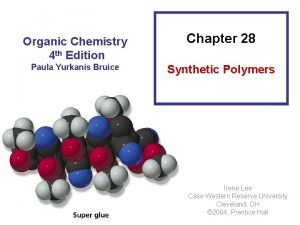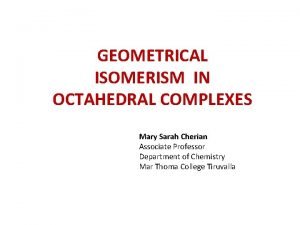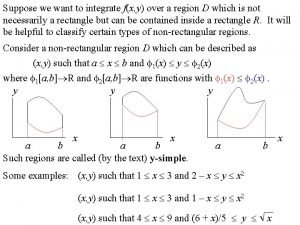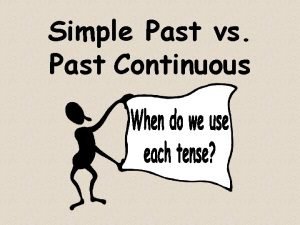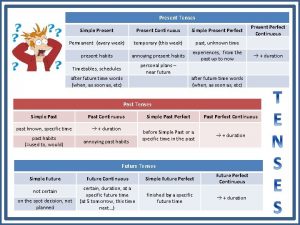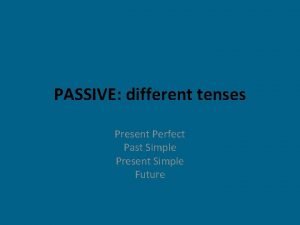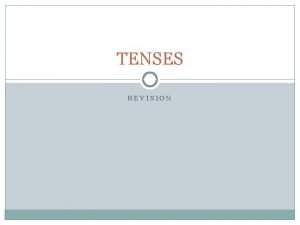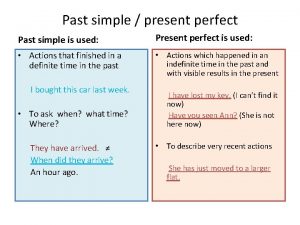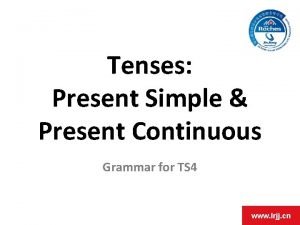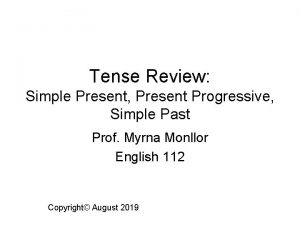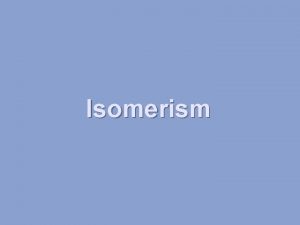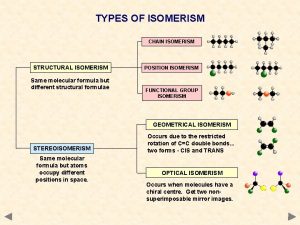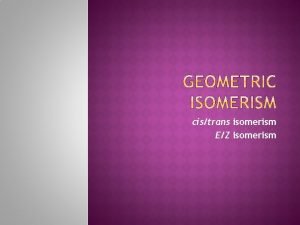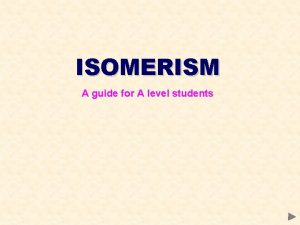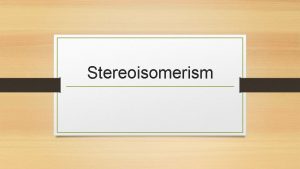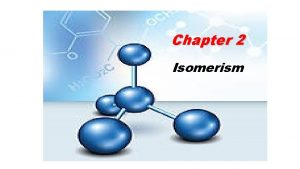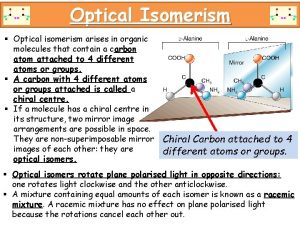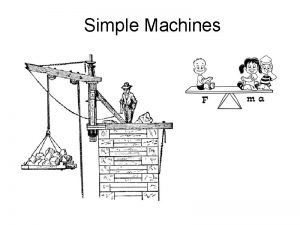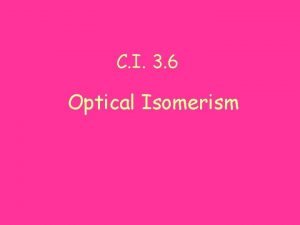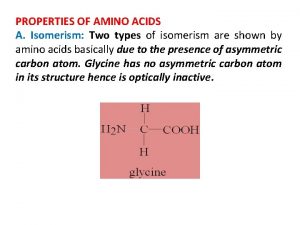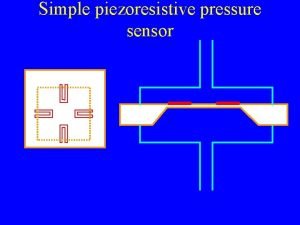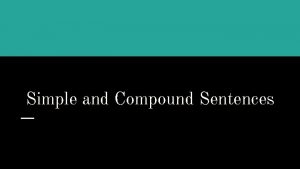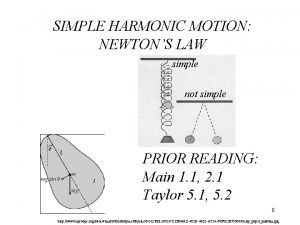2 1 7 simple ISOMERISM Types of isomerism








































- Slides: 40

2. 1. 7 simple. . ISOMERISM • Types of isomerism • Structural isomerism • Stereoisomerism • Geometrical isomerism • Optical isomerism Before you start it would be helpful to… • know the functional groups found in organic chemistry • know the arrangement of bonds around carbon atoms • know what affects the boiling point of organic molecules


TYPES OF ISOMERISM CHAIN ISOMERISM STRUCTURAL ISOMERISM Same molecular formula but different structural formulae POSITION ISOMERISM FUNCTIONAL GROUP ISOMERISM GEOMETRICAL ISOMERISM STEREOISOMERISM Same molecular formula but atoms occupy different positions in space. Occurs due to the restricted rotation of C=C double bonds. . . two forms… E and Z (CIS and TRANS) OPTICAL ISOMERISM Occurs when molecules have a chiral centre. Get two nonsuperimposable mirror images.

STRUCTURAL ISOMERISM - INTRODUCTION COMPOUNDS HAVE THE SAME MOLECULAR FORMULA BUT DIFFERENT STRUCTURAL FORMULA Chain different arrangements of the carbon skeleton similar chemical properties slightly different physical properties more branching = lower boiling point

STRUCTURAL ISOMERISM - INTRODUCTION COMPOUNDS HAVE THE SAME MOLECULAR FORMULA BUT DIFFERENT STRUCTURAL FORMULA Chain different arrangements of the carbon skeleton similar chemical properties slightly different physical properties more branching = lower boiling point Positional same carbon skeleton same functional group is in a different position similar chemical properties - slightly different physical properties

STRUCTURAL ISOMERISM - INTRODUCTION COMPOUNDS HAVE THE SAME MOLECULAR FORMULA BUT DIFFERENT STRUCTURAL FORMULA Chain different arrangements of the carbon skeleton similar chemical properties slightly different physical properties more branching = lower boiling point Positional same carbon skeleton same functional group is in a different position similar chemical properties - slightly different physical properties Functional Group different functional group different chemical properties different physical properties • Sometimes more than one type of isomerism occurs in the same molecule. • The more carbon atoms there are, the greater the number of possible isomers

STRUCTURAL ISOMERISM - CHAIN caused by different arrangements of the carbon skeleton similar chemical properties slightly different physical properties more branching = lower boiling point There are two structural isomers of C 4 H 10. One is a straight chain molecule where all the carbon atoms are in a single row. The other is a branched molecule where three carbon atoms are in a row and one carbon atom sticks out of the main chain. BUTANE straight chain 2 -METHYLPROPANE branched C 4 H 10

STRUCTURAL ISOMERISM - CHAIN DIFFERENCES BETWEEN CHAIN ISOMERS Chemical Isomers show similar chemical properties because the same functional group is present. Physical Properties such as density and boiling point show trends according to the of the degree of branching Boiling Point “straight” chain isomers have higher values than branched ones the greater the degree of branching the lower the boiling point branching decreases the effectiveness of intermolecular forces less energy has to be put in to separate the molecules - 0. 5°C straight chain - 11. 7°C branched greater branching = lower boiling point

STRUCTURAL ISOMERISM - POSITIONAL molecule has the same carbon skeleton molecule has the same functional group. . . BUT the functional group is in a different position have similar chemical properties / different physical properties Example 1 POSITION OF A DOUBLE BOND IN ALKENES 1 2 PENT-1 -ENE double bond between carbons 1 and 2 2 3 PENT-2 -ENE double bond between carbons 2 and 3 There are no other isomers with five C’s in the longest chain but there are three other structural isomers with a chain of four carbons plus one in a branch.

STRUCTURAL ISOMERISM - POSITIONAL molecule has the same carbon skeleton molecule has the same functional group. . . BUT the functional group is in a different position have similar chemical properties / different physical properties Example 2 POSITION OF A HALOGEN IN A HALOALKANE 1 1 -CHLOROBUTANE halogen on carbon 1 2 2 -CHLOROBUTANE halogen on carbon 2 BUT 2 is NOT 3 -CHLOROBUTANE Moving the chlorine along the chain makes new isomers; the position is measured from the end nearest the functional group. . . the third example is 2 - NOT 3 -chlorobutane. There are 2 more structural isomers of C 4 H 9 Cl but they have a longest chain of 3

STRUCTURAL ISOMERISM - POSITIONAL molecule has the same carbon skeleton molecule has the same functional group. . . BUT the functional group is in a different position have similar chemical properties / different physical properties Example 3 RELATIVE POSITIONS ON A BENZENE RING 1, 2 -DICHLOROBENZENE ortho dichlorobenzene 1, 3 -DICHLOROBENZENE meta dichlorobenzene 1, 4 -DICHLOROBENZENE para dichlorobenzene

STRUCTURAL ISOMERISM – FUNCTIONAL GROUP molecules have same molecular formula molecules have different functional groups molecules have different chemical properties molecules have different physical properties ALCOHOLS and ETHERS ALDEHYDES and KETONES ACIDS and ESTERS

STEREOISOMERISM Molecules have the SAME MOLECULAR FORMULA but the atoms are joined to each other in a DIFFERENT SPACIAL ARRANGEMENT - they occupy a different position in 3 -dimensional space. There are two types. . . • GEOMETRICAL ISOMERISM • OPTICAL ISOMERISM

GEOMETRICAL ISOMERISM IN ALKENES Introduction • • an example of stereoisomerism found in some, but not all, alkenes occurs due to the RESTRICTED ROTATION OF C=C bonds get two forms. . .

GEOMETRICAL ISOMERISM IN ALKENES Introduction • • an example of stereoisomerism found in some, but not all, alkenes occurs due to the RESTRICTED ROTATION OF C=C bonds get two forms. . . CIS (Z) Groups/atoms are on the SAME SIDE of the double bond TRANS (E) Groups/atoms are on OPPOSITE SIDES across the double bond

GEOMETRICAL ISOMERISM RESTRICTED ROTATION OF C=C BONDS Single covalent bonds can easily rotate. What appears to be a different structure is not. It looks like it but, due to the way structures are written out, they are the same. ALL THESE STRUCTURES ARE THE SAME BECAUSE C-C BONDS HAVE ‘FREE’ ROTATION

GEOMETRICAL ISOMERISM RESTRICTED ROTATION OF C=C BONDS C=C bonds have restricted rotation so the groups on either end of the bond are ‘frozen’ in one position; it isn’t easy to flip between the two. This produces two possibilities. The two structures cannot interchange easily so the atoms in the two molecules occupy different positions in space.

GEOMETRICAL ISOMERISM IN ALKENES E/Z or CIS-TRANS E/Z Z (zusammen) higher priority groups / atoms on the SAME side of C=C bond E (entgegen) higher priority groups / atoms on OPPOSITE sides of C=C bond

GEOMETRICAL ISOMERISM IN ALKENES E/Z or CIS-TRANS E/Z Z (zusammen) higher priority groups / atoms on the SAME side of C=C bond E (entgegen) higher priority groups / atoms on OPPOSITE sides of C=C bond To determine priority, the Cahn, Ingold and Prelog convention is used. eg C 2 H 5 > CH 3 > H and I > Br > Cl > F > C > H

GEOMETRICAL ISOMERISM IN ALKENES E/Z or CIS-TRANS E/Z Z (zusammen) higher priority groups / atoms on the SAME side of C=C bond E (entgegen) higher priority groups / atoms on OPPOSITE sides of C=C bond To determine priority, the Cahn, Ingold and Prelog convention is used. eg C 2 H 5 > CH 3 > H and I > Br > Cl > F > C > H

GEOMETRICAL ISOMERISM IN ALKENES E/Z or CIS-TRANS E/Z Z (zusammen) higher priority groups / atoms on the SAME side of C=C bond E (entgegen) higher priority groups / atoms on OPPOSITE sides of C=C bond To determine priority, the Cahn, Ingold and Prelog convention is used. eg E C 2 H 5 > CH 3 > H Z and I > Br > Cl > F > C > H Z E

GEOMETRICAL ISOMERISM IN ALKENES E/Z or CIS-TRANS CIS / TRANS Should only be used when there are two H’s and two nonhydrogen groups attached to each carbon. cis non-hydrogen groups / atoms on the SAME side of C=C bond trans non-hydrogen groups / atoms on OPPOSITE sides of C=C bond

GEOMETRICAL ISOMERISM IN ALKENES E/Z or CIS-TRANS CIS / TRANS Should only be used when there are two H’s and two nonhydrogen groups attached to each carbon. cis non-hydrogen groups / atoms on the SAME side of C=C bond trans non-hydrogen groups / atoms on OPPOSITE sides of C=C bond

GEOMETRICAL ISOMERISM IN ALKENES E/Z or CIS-TRANS CIS / TRANS Should only be used when there are two H’s and two nonhydrogen groups attached to each carbon. cis non-hydrogen groups / atoms on the SAME side of C=C bond trans non-hydrogen groups / atoms on OPPOSITE sides of C=C bond cis trans

GEOMETRICAL ISOMERISM Isomerism in butene There are 3 structural isomers of C 4 H 8 that are alkenes*. Of these ONLY ONE exhibits geometrical isomerism. but-1 -ene cis but-2 -ene (Z) but-2 -ene trans but-2 -ene (E) but-2 -ene 2 -methylpropene * YOU CAN GET ALKANES WITH FORMULA C 4 H 8 IF THE CARBON ATOMS ARE IN A RING

GEOMETRICAL ISOMERISM How to tell if it exists Two different atoms/groups attached Two similar atoms/groups attached Two different atoms/groups attached GEOMETRICAL ISOMERISM Once you get two similar atoms/groups attached to one end of a C=C, you cannot have geometrical isomerism GEOMETRICAL ISOMERISM

GEOMETRIC ISOMERISM (E) but-2 -ene E entgegen (opposite) (Z) but-2 -ene Z zusammen (together)

GEOMETRIC ISOMERISM PRIORITY: H < CH 3 < CH 2 CH 3 Look at atomic numbers of atoms attached to C=C (or subsequent atoms if the same). Highest values opposite = E Highest values together = Z Z 2 -bromo-2 -fluorobut-2 -ene E 3 -methylpent-2 -ene

TASK NO methylpropene YES Z 1 -chloropropene E

TASK NO 2 -methylpent-2 -ene NO 2 -ethylpent-1 -ene

TASK YES E Z 3 -methylpent-2 -ene NO but-1 -ene

TASK YES Z E 3, 4 -dimethylhex-3 -ene YES Z 2 -bromo-3 -chlorobut-2 -ene E




Tasks Page 114 – 115 Key definitions Stereoisomers are. . . E/Z isomerism is. . Cis-trans isomerism. . Questions : 1, 2, 3, 4




 Unsaturated compounds
Unsaturated compounds Optical isomerism octahedral complexes
Optical isomerism octahedral complexes 2-hydroxypropanenitrile displays optical isomerism
2-hydroxypropanenitrile displays optical isomerism Conformational isomers
Conformational isomers L and d isomers
L and d isomers C6h14 structural isomers
C6h14 structural isomers Abstract classes in java
Abstract classes in java Optical isomerism worksheet
Optical isomerism worksheet Order of strength of ligands
Order of strength of ligands Structural isomers
Structural isomers Polymerization isomerism
Polymerization isomerism Define geometrical isomerism
Define geometrical isomerism Simple past future
Simple past future Present simple future simple past simple
Present simple future simple past simple Past continuous present simple
Past continuous present simple Present simple present continuous past simple
Present simple present continuous past simple Simple present simple past and simple future
Simple present simple past and simple future Present simple past simple future simple present continuous
Present simple past simple future simple present continuous Past future tense adalah
Past future tense adalah Present simple exemplos
Present simple exemplos Future simple present simple
Future simple present simple Is electrical tape a tool or material
Is electrical tape a tool or material X simple and y simple
X simple and y simple Simple predicate meaning
Simple predicate meaning Simple past and simple continuous
Simple past and simple continuous Run present perfect
Run present perfect Present perfect continuous vs past simple
Present perfect continuous vs past simple Present perfect continuous signaalwoorden
Present perfect continuous signaalwoorden Present perfect passive
Present perfect passive Diferencia entre pasado simple y presente perfecto
Diferencia entre pasado simple y presente perfecto Bankers rule
Bankers rule Present simple passive grow
Present simple passive grow Passive voice simple present and simple past exercises
Passive voice simple present and simple past exercises Present simple function
Present simple function Present simple present continuous past simple
Present simple present continuous past simple Simple past tense of forgive
Simple past tense of forgive Past present continuous
Past present continuous Present simple present continuous grammar
Present simple present continuous grammar Simple present present progressive simple past
Simple present present progressive simple past If present simple present simple
If present simple present simple Simple past vs simple present
Simple past vs simple present
